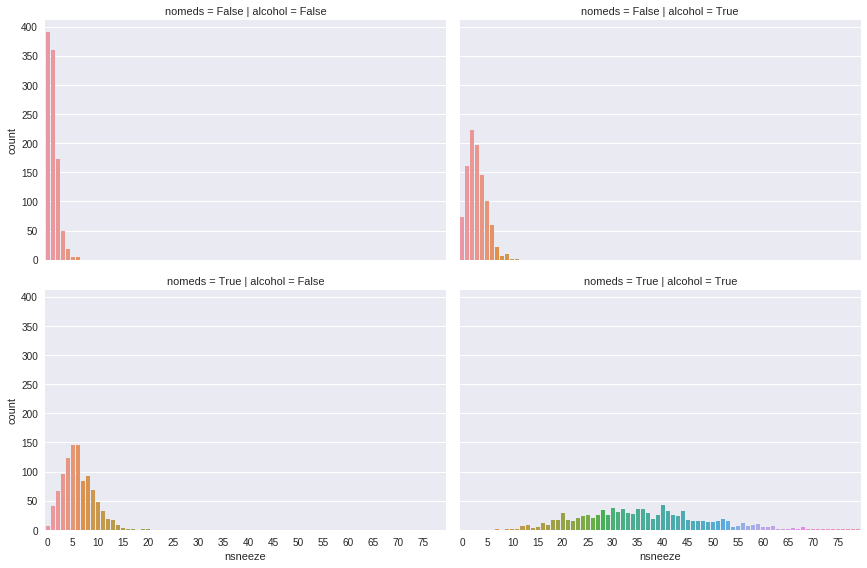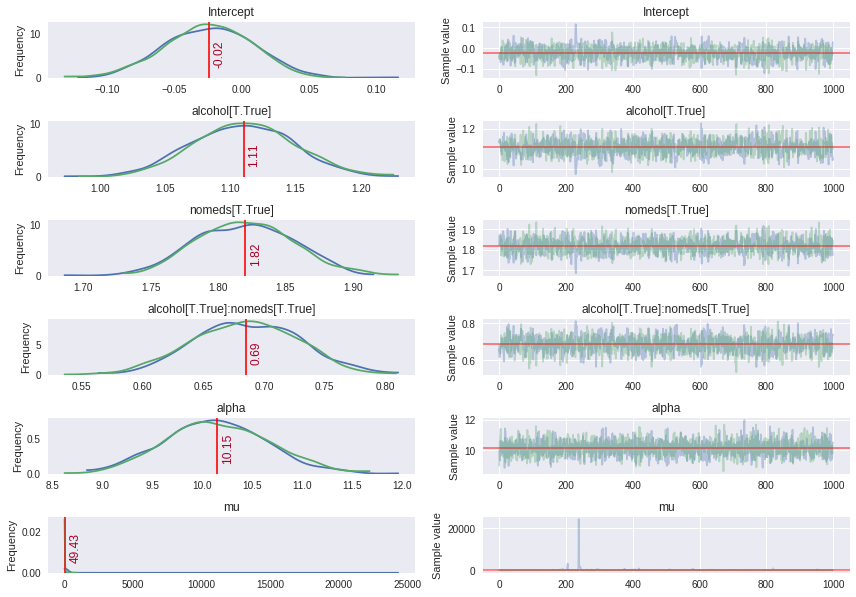GLM: Negative Binomial Regression¶
This notebook demos negative binomial regression using the glm
submodule. It closely follows the GLM Poisson regression example by
Jonathan Sedar (which is in turn
insipired by a project by Ian
Osvald)
except the data here is negative binomially distributed instead of
Poisson distributed.
Negative binomial regression is used to model count data for which the variance is higher than the mean. The negative binomial distribution can be thought of as a Poisson distribution whose rate parameter is gamma distributed, so that rate parameter can be adjusted to account for the increased variance.
Contents¶
Setup¶
In [1]:
import numpy as np
import pandas as pd
import pymc3 as pm
from scipy import stats
from scipy import optimize
import matplotlib.pyplot as plt
import seaborn as sns
import re
%matplotlib inline
Convenience Functions¶
Taken from the Poisson regression example.
In [2]:
def plot_traces(trcs, varnames=None):
'''Plot traces with overlaid means and values'''
nrows = len(trcs.varnames)
if varnames is not None:
nrows = len(varnames)
ax = pm.traceplot(trcs, varnames=varnames, figsize=(12,nrows*1.4),
lines={k: v['mean'] for k, v in
pm.df_summary(trcs,varnames=varnames).iterrows()})
for i, mn in enumerate(pm.df_summary(trcs, varnames=varnames)['mean']):
ax[i,0].annotate('{:.2f}'.format(mn), xy=(mn,0), xycoords='data',
xytext=(5,10), textcoords='offset points', rotation=90,
va='bottom', fontsize='large', color='#AA0022')
def strip_derived_rvs(rvs):
'''Remove PyMC3-generated RVs from a list'''
ret_rvs = []
for rv in rvs:
if not (re.search('_log',rv.name) or re.search('_interval',rv.name)):
ret_rvs.append(rv)
return ret_rvs
Generate Data¶
As in the Poisson regression example, we assume that sneezing occurs at some baseline rate, and that consuming alcohol, not taking antihistamines, or doing both, increase its frequency.
Poisson Data¶
First, let’s look at some Poisson distributed data from the Poisson regression example.
In [3]:
np.random.seed(123)
In [4]:
# Mean Poisson values
theta_noalcohol_meds = 1 # no alcohol, took an antihist
theta_alcohol_meds = 3 # alcohol, took an antihist
theta_noalcohol_nomeds = 6 # no alcohol, no antihist
theta_alcohol_nomeds = 36 # alcohol, no antihist
# Create samples
q = 1000
df_pois = pd.DataFrame({
'nsneeze': np.concatenate((np.random.poisson(theta_noalcohol_meds, q),
np.random.poisson(theta_alcohol_meds, q),
np.random.poisson(theta_noalcohol_nomeds, q),
np.random.poisson(theta_alcohol_nomeds, q))),
'alcohol': np.concatenate((np.repeat(False, q),
np.repeat(True, q),
np.repeat(False, q),
np.repeat(True, q))),
'nomeds': np.concatenate((np.repeat(False, q),
np.repeat(False, q),
np.repeat(True, q),
np.repeat(True, q)))})
In [5]:
df_pois.groupby(['nomeds', 'alcohol'])['nsneeze'].agg(['mean', 'var'])
Out[5]:
| mean | var | ||
|---|---|---|---|
| nomeds | alcohol | ||
| False | False | 0.989 | 1.019899 |
| True | 2.973 | 2.985256 | |
| True | False | 5.948 | 5.907203 |
| True | 36.163 | 39.493925 |
Since the mean and variance of a Poisson distributed random variable are equal, the sample means and variances are very close.
Negative Binomial Data¶
Now, suppose every subject in the dataset had the flu, increasing the variance of their sneezing (and causing an unfortunate few to sneeze over 70 times a day). If the mean number of sneezes stays the same but variance increases, the data might follow a negative binomial distribution.
In [6]:
# Gamma shape parameter
alpha = 10
def get_nb_vals(mu, alpha, size):
"""Generate negative binomially distributed samples by
drawing a sample from a gamma distribution with mean `mu` and
shape parameter `alpha', then drawing from a Poisson
distribution whose rate parameter is given by the sampled
gamma variable.
"""
g = stats.gamma.rvs(alpha, scale=mu / alpha, size=size)
return stats.poisson.rvs(g)
# Create samples
n = 1000
df = pd.DataFrame({
'nsneeze': np.concatenate((get_nb_vals(theta_noalcohol_meds, alpha, n),
get_nb_vals(theta_alcohol_meds, alpha, n),
get_nb_vals(theta_noalcohol_nomeds, alpha, n),
get_nb_vals(theta_alcohol_nomeds, alpha, n))),
'alcohol': np.concatenate((np.repeat(False, n),
np.repeat(True, n),
np.repeat(False, n),
np.repeat(True, n))),
'nomeds': np.concatenate((np.repeat(False, n),
np.repeat(False, n),
np.repeat(True, n),
np.repeat(True, n)))})
In [7]:
df.groupby(['nomeds', 'alcohol'])['nsneeze'].agg(['mean', 'var'])
Out[7]:
| mean | var | ||
|---|---|---|---|
| nomeds | alcohol | ||
| False | False | 0.976 | 1.106531 |
| True | 2.961 | 3.619098 | |
| True | False | 6.022 | 9.505021 |
| True | 36.254 | 167.348833 |
As in the Poisson regression example, we see that drinking alcohol
and/or not taking antihistamines increase the sneezing rate to varying
degrees. Unlike in that example, for each combination of alcohol and
nomeds, the variance of nsneeze is higher than the mean. This
suggests that a Poisson distrubution would be a poor fit for the data
since the mean and variance of a Poisson distribution are equal.
In [8]:
g = sns.factorplot(x='nsneeze', row='nomeds', col='alcohol', data=df, kind='count', aspect=1.5)
# Make x-axis ticklabels less crowded
ax = g.axes[1, 0]
labels = range(len(ax.get_xticklabels(which='both')))
ax.set_xticks(labels[::5])
ax.set_xticklabels(labels[::5]);

Negative Binomial Regression¶
Create GLM Model¶
In [9]:
fml = 'nsneeze ~ alcohol + nomeds + alcohol:nomeds'
with pm.Model() as model:
pm.glm.GLM.from_formula(formula=fml, data=df, family=pm.glm.families.NegativeBinomial())
# Old initialization
# start = pm.find_MAP(fmin=optimize.fmin_powell)
# C = pm.approx_hessian(start)
# trace = pm.sample(4000, step=pm.NUTS(scaling=C))
trace = pm.sample(2000, njobs=2)
Auto-assigning NUTS sampler...
Initializing NUTS using ADVI...
Average Loss = 10,338: 7%|▋ | 13828/200000 [00:22<06:19, 490.54it/s]
Convergence archived at 13900
Interrupted at 13,900 [6%]: Average Loss = 14,046
100%|██████████| 2500/2500 [11:04<00:00, 2.93it/s]
View Results¶
In [10]:
rvs = [rv.name for rv in strip_derived_rvs(model.unobserved_RVs)]
plot_traces(trace[1000:], varnames=rvs);

In [11]:
# Transform coefficients to recover parameter values
np.exp(pm.df_summary(trace[1000:], varnames=rvs)[['mean','hpd_2.5','hpd_97.5']])
Out[11]:
| mean | hpd_2.5 | hpd_97.5 | |
|---|---|---|---|
| Intercept | 9.758611e-01 | 0.913428 | 1.032908e+00 |
| alcohol[T.True] | 3.034905e+00 | 2.820879 | 3.267148e+00 |
| nomeds[T.True] | 6.170180e+00 | 5.774109 | 6.613178e+00 |
| alcohol[T.True]:nomeds[T.True] | 1.984273e+00 | 1.833042 | 2.161982e+00 |
| alpha | 2.548632e+04 | 9936.840573 | 7.110099e+04 |
| mu | 2.925866e+21 | 1.004314 | 1.691800e+54 |
The mean values are close to the values we specified when generating the data: - The base rate is a constant 1. - Drinking alcohol triples the base rate. - Not taking antihistamines increases the base rate by 6 times. - Drinking alcohol and not taking antihistamines doubles the rate that would be expected if their rates were independent. If they were independent, then doing both would increase the base rate by 3*6=18 times, but instead the base rate is increased by 3*6*2=16 times.
Finally, even though the sample for mu is highly skewed, its median
value is close to the sample mean, and the mean of alpha is also
quite close to its actual value of 10.
In [12]:
np.percentile(trace[1000:]['mu'], [25,50,75])
Out[12]:
array([ 4.25400876, 11.2521235 , 27.12410786])
In [13]:
df.nsneeze.mean()
Out[13]:
11.55325
In [14]:
trace[1000:]['alpha'].mean()
Out[14]:
10.145896982642357